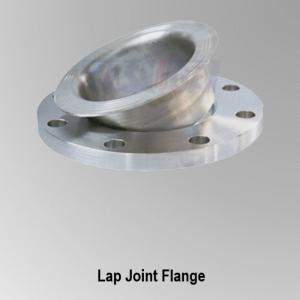

Add to Cart
Lap Joint Flange LJF ASTM A182 ASME / ANSI B16.5 Class 150 to 2500
Lap Joint Flange
Attachment of the lap joint flange to the piping system requires a lap-joint stub end. The stub end can be viewed as a length of pipe sleeve with one end butt welded and the other end flared at right angle to the pipe axis. The lap-joint flange and stub end compose a two-piece composite lap joint connection.
In this lapped connection, prior to the “pipe sleeve” being welded to the adjoining pipe, and the loose-type lap joint flange slip over the straight length of the pipe sleeve and abuts against the back face of the stub end or its “flared shoulder”. It is free to spin the flange for proper alignment of bolt holes, which is used to bolt the joint together subsequently. The lap joint flange is also known as a lapped “backing flange” and the flared end is also called as “lap” of the stub end.
Product Information
| Product Name | Lap Joint Stainless Steel Flange |
| Size Range | 1/2’ to 24” |
| Pressure Class | 150, 300, 400, 600, 900, 1500, 2500, |
| Standards | ASTM A182 |
| Face Type | Lap Joint (LJ) |
| Dimensions | ANSI B16.5, Custom Drawings |
| Thickness | Sch5S to Sch160, XXS |
| Origin | China |
| Applications | Low stress piping system which needs frequent dismantling or routine maintenance |
| Test | Direct-reading Spectrograph, Hydrostatic testing machine, X-ray detector, Ultrasonic flaw detector, Magnetic particle detector |
| Test Certificates | Raw Materials Certificate, 100% Radiography Test Report, Third Party Inspection Report |
Advantages & Disadvantages of Lap Joint Flange
Due to the composite two-piece configuration, the lap joint flange obtains two advantages in use. Imagine a lapped joint piping connection in which an expensive alloy (nickel, zirconium, tantalum, or titanium, etc) is required for all “wetted” parts to resist corrosion. The stub end can be made from the corrosion-resistant but expensive alloy and the lap joint flange functioning as a backing flange may be made from common carbon steels. This is more cost-effective than a complete alloy flange. On the other hand, since the lap joint flange itself is not welded to the pipe, it may rotate to align bolt holes readily and the assembly and disassembly are much easier. This facilitates the operation of a piping system that requires frequent dismantling for inspection or routine maintenance.
There are also some disadvantages for using lap joint flanges. The crevices formed between the internal surface of flange bore and the external surface of the stub ends may collect contaminates. And the collected contaminates could cause a problem and result in crevice corrosion. The longitudinal stresses, resulting from pressure, weight, and thermal expansion, may accumulate and exceed the basic allowable stress at the design temperature stipulated by ASME B31.3. Hence the lap joint flange is generally used in the circumstance, when the loads applied by the pipe to the flange connection are small. Since the lap joint flange may be of a material different from that of the stub end, possible galvanic corrosion may be incurred in some situations.
Dimension of ASME/ANSI B16.5
